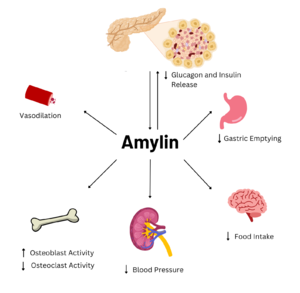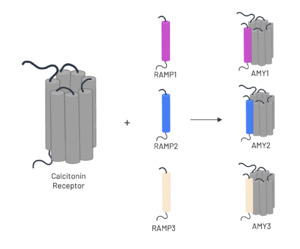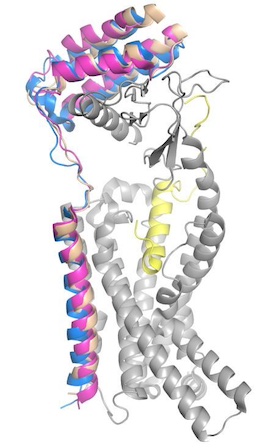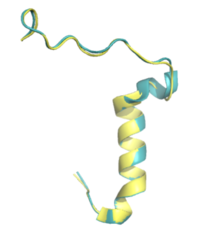User:Brynn Baker/Sandbox1
From Proteopedia
(Difference between revisions)
| Line 6: | Line 6: | ||
== Amylin == | == Amylin == | ||
| - | [[Image:AmylinFlowchart.png|300 px|right|thumb|Figure 1. Effects of Amylin in Humans]] | + | [[Image:AmylinFlowchart.png|300 px|right|thumb|Figure 1. Effects of Amylin in Humans. Image generated using ''Biorender''.]] |
Amylin is a neuroendocrine hormone that is synthesized with insulin in the [https://en.wikipedia.org/wiki/Beta_cell beta cells] of pancreatic islets. It can cross the [https://en.wikipedia.org/wiki/Blood%E2%80%93brain_barrier blood-brain barrier] and regulates glucose homeostasis via inhibiting gastric emptying, inhibiting the release of glucagon, and inducing meal-ending satiety<ref name="Hay">PMID:26071095</ref>. In doing so, it prevents spikes in blood glucose and overeating, making it a suitable target for [https://en.wikipedia.org/wiki/Type_2_diabetes Type 2 Diabetes] treatments and therapies. Since Type 2 Diabetes is a major risk factor for [https://en.wikipedia.org/wiki/Alzheimer%27s_disease Alzheimer's Disease], as Type 2 Diabetes cases continue to increase, there will likely be a spike in Alzheimer’s Disease as well<ref name="Grizzanti">PMID:30282360</ref>. Therefore, it is vital that amylin, its receptor, and analogs, such as pramlintide, are understood to aid in rational drug design. | Amylin is a neuroendocrine hormone that is synthesized with insulin in the [https://en.wikipedia.org/wiki/Beta_cell beta cells] of pancreatic islets. It can cross the [https://en.wikipedia.org/wiki/Blood%E2%80%93brain_barrier blood-brain barrier] and regulates glucose homeostasis via inhibiting gastric emptying, inhibiting the release of glucagon, and inducing meal-ending satiety<ref name="Hay">PMID:26071095</ref>. In doing so, it prevents spikes in blood glucose and overeating, making it a suitable target for [https://en.wikipedia.org/wiki/Type_2_diabetes Type 2 Diabetes] treatments and therapies. Since Type 2 Diabetes is a major risk factor for [https://en.wikipedia.org/wiki/Alzheimer%27s_disease Alzheimer's Disease], as Type 2 Diabetes cases continue to increase, there will likely be a spike in Alzheimer’s Disease as well<ref name="Grizzanti">PMID:30282360</ref>. Therefore, it is vital that amylin, its receptor, and analogs, such as pramlintide, are understood to aid in rational drug design. | ||
| Line 27: | Line 27: | ||
== Amylin Receptor == | == Amylin Receptor == | ||
The amylin receptor (AMYR) is the result of the heterodimerization of the <scene name='10/1037516/Ct/2'>calcitonin receptor</scene> and a RAMP, such as <scene name='10/1037520/Ramp3/5'>RAMP3</scene>. The patterns of peptide interaction between CT and AMYR are very similar overall, but amylin has a higher affinity for AMYR1 and AMYR3 than AMYR2<ref name="Cao">PMID:35324283</ref>. | The amylin receptor (AMYR) is the result of the heterodimerization of the <scene name='10/1037516/Ct/2'>calcitonin receptor</scene> and a RAMP, such as <scene name='10/1037520/Ramp3/5'>RAMP3</scene>. The patterns of peptide interaction between CT and AMYR are very similar overall, but amylin has a higher affinity for AMYR1 and AMYR3 than AMYR2<ref name="Cao">PMID:35324283</ref>. | ||
| - | [[Image:AMYR.png|300 px|left|thumb|Figure 3. Heterodimerization of CT and RAMPs]] | + | [[Image:AMYR.png|300 px|left|thumb|Figure 3. Heterodimerization of CT and RAMPs. Image generated using ''Biorender''.]] |
== Calcitonin Receptor and G-alpha Interactions == | == Calcitonin Receptor and G-alpha Interactions == | ||
Revision as of 16:38, 29 April 2024
Homo sapiens Amylin3 Receptor, AMYR3
| |||||||||||
References
- ↑ Hay DL, Chen S, Lutz TA, Parkes DG, Roth JD. Amylin: Pharmacology, Physiology, and Clinical Potential. Pharmacol Rev. 2015 Jul;67(3):564-600. PMID:26071095 doi:10.1124/pr.115.010629
- ↑ 2.0 2.1 Grizzanti J, Corrigan R, Casadesus G. Neuroprotective Effects of Amylin Analogues on Alzheimer's Disease Pathogenesis and Cognition. J Alzheimers Dis. 2018;66(1):11-23. PMID:30282360 doi:10.3233/JAD-180433
- ↑ 3.0 3.1 3.2 3.3 3.4 3.5 3.6 3.7 3.8 3.9 Cao J, Belousoff MJ, Liang YL, Johnson RM, Josephs TM, Fletcher MM, Christopoulos A, Hay DL, Danev R, Wootten D, Sexton PM. A structural basis for amylin receptor phenotype. Science. 2022 Mar 25;375(6587):eabm9609. PMID:35324283 doi:10.1126/science.abm9609
- ↑ 4.0 4.1 Bower RL, Hay DL. Amylin structure-function relationships and receptor pharmacology: implications for amylin mimetic drug development. Br J Pharmacol. 2016 Jun;173(12):1883-98. PMID:27061187 doi:10.1111/bph.13496
Student Contributors
- Brynn Baker
- Emily Berkman
- Sepp Hall





